
In this photo released by Rio de Janeiro state's press office, homes affected by rains and landslides are seen in the Morro de Borel neighborhood of Rio de Janeiro, Wednesday, April 7, 2010. The heaviest rains in Rio de Janeiro's history triggered landslides Tuesday that killed at least 95 people as rising water turned roads into rivers and paralyzed Brazil's second-largest city.

Firefighters stand around the body of a person who was killed in a landslide in the Morro dos Prazeres area of the Santa Teresa neighborhood in Rio de Janeiro, Wednesday, April 7, 2010. The heaviest rains in Rio de Janeiro's history triggered landslides Tuesday that killed at least 95 people as rising water turned roads into rivers and paralyzed Brazil's second-largest city.
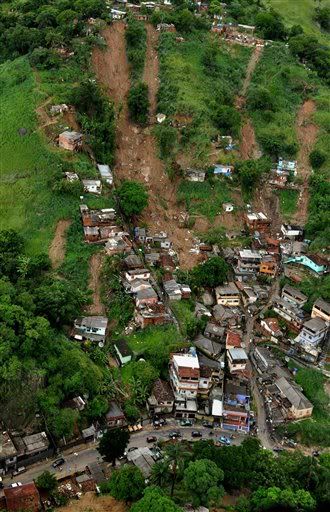
In this photo released by Rio de Janeiro state's press office, homes are seen in a neighborhood affected by the rain and landslides in Niteroi, Brazil, Wednesday, April 7, 2010. The heaviest rains in Rio de Janeiro's history triggered landslides Tuesday that killed at least 95 people as rising water turned roads into rivers and paralyzed Brazil's second-largest city.
Beleaguered rescue workers struggled early Thursday to find survivors after another mudslide surged into a rain-sodden hillside shantytown, engulfing at least 40 homes in a huge cascade of mud.
The state Civil Defense department said the latest slide unleashed by heavy rains hit in Rio's neighboring city of Niteroi. There was no word on how many were missing, but it was feared dozens were buried under the debris.
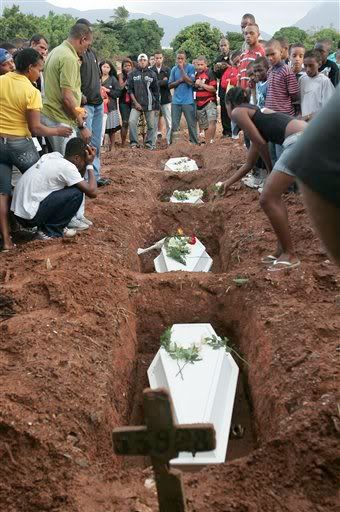
The coffins of the brothers Joice da Silva, 13, Jean da Silva, 9, Joel da Silva, and their aunt Rebeca, 12, who died in a landslide are buried at the Caju cemetery in Rio de Janeiro, Wednesday, April 7, 2010. The heaviest rains in Rio de Janeiro's history triggered landslides Tuesday that killed at least 138 people as rising water turned roads into rivers and paralyzed Brazil's second-largest city
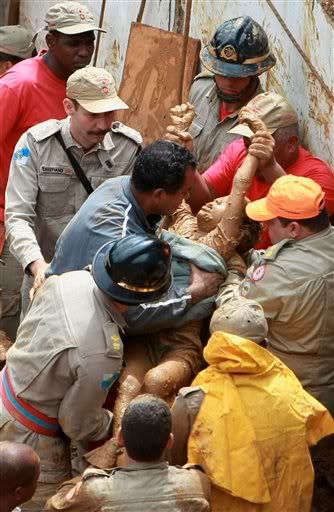
Valmir Franca da Matta embraces his son Marcos Vinicius, 9, as rescue workers pull his body from the debris after a landslide in the Morro dos Prazeres area of the Santa Teresa neighborhood in Rio de Janeiro, Wednesday, April 7, 2010. Flooding and mudslides from the heaviest deluge ever recorded in Rio killed at least 100 people and left many more homeless, officials said Wednesday as the rains finally began to ease. (
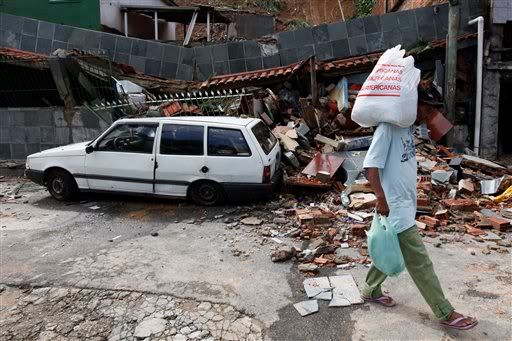
A resident carries items away from an area damaged by a landslide in the Caixa D'agua area of Niteroi, Brazil, Wednesday, April 7, 2010. Flooding and mudslides from the heaviest deluge ever recorded in Rio killed at least 100 people and left many more homeless, officials said Wednesday as the rains finally began to ease.
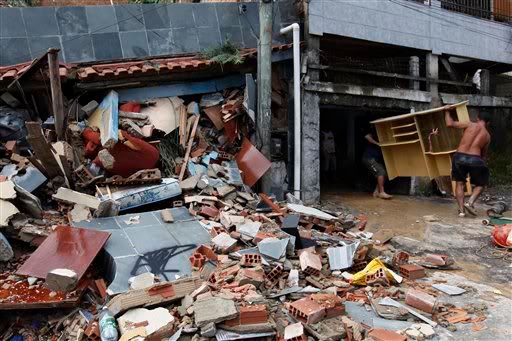
Residents remove belongings from their damaged home after heavy rains and landslides in the Caixa D'agua area in Niteroi, Brazil, Wednesday, April 7, 2010. Flooding and mudslides from the heaviest deluge ever recorded in Rio killed at least 100 people and left many more homeless, officials said Wednesday as the rains finally began to ease.
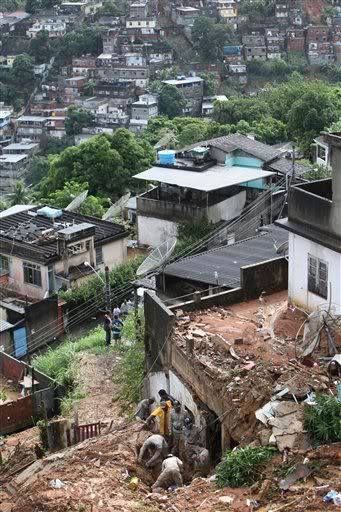
Firefighters work to pull a body from the debris after a landslide in the Morro dos Prazeres area of the Santa Teresa neighborhood in Rio de Janeiro, Wednesday, April 7, 2010. The heaviest rains in Rio de Janeiro's history triggered landslides Tuesday that killed at least 95 people as rising water turned roads into rivers and paralyzed Brazil's second-largest city
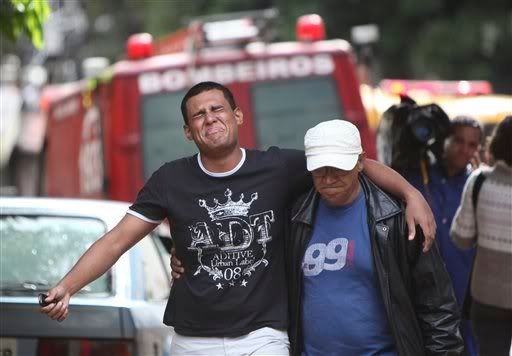
A man mourns for victim who died in a landslide in the Morro dos Prazeres area of the Santa Teresa neighborhood in Rio de Janeiro, Wednesday, April 7, 2010. The heaviest rains in Rio de Janeiro's history triggered landslides Tuesday that killed at least 95 people as rising water turned roads into rivers and paralyzed Brazil's second-largest city.

At least 145 people have been killed, mostly by landslides swept through slum areas
Although rain let up some late Wednesday, Alves Souza, commander of the firefighters in the Niteroi rescue operations carried out under electric lights, said the work was moving slowly. The wet, steep terrain made it dangerous for anyone trapped in the wreckage and those trying to pull victims out.
"We've managed to recover two bodies and the work is very intense, given the fact that the volume of material we have here is very large," Souza told the Globo television network.
Record rainfall since Monday afternoon triggered deadly mudslides across Rio's metropolitan area, causing at least 147 deaths. At least 60 people were missing, but that didn't include the dozens likely buried under the latest slide that hit Niteroi.
On Wednesday, Rodrigo de Almeira had dug for 15 hours through mud and debris, and he looked like it. Auburn mud covered his head, his ripped shirt, his torn jeans and his rubber sandals.
When asked if he had been able to save anyone from a landslide in the Pleasure Hill slum where he lives, he silently shook his head.
"Right there at least 15 people I know died," Almeira said, staring at a mound of mud and debris. Wood planks — remnants of the shacks engulfed by the surging earth — poked through the mud as 30 rescue workers gingerly dug at it with picks and shovels looking for survivors.
"We found a guy alive this morning, so we had hope," said Almeira, 28. "He didn't make it. We were told he died on his way to the hospital."
Because of the continuing rains, steep hillsides and loose earth, officials said there had been few successful rescues. One man, Carlos Eduardo Silva dos Santos, 24, was pulled alive from under a concrete wall in western Rio. Firefighters said they had no count on how many people had been rescued.
Nearly all the deaths occurred in mudslides that smashed through slums, yet another reminder that life in one of the world's most famous playgrounds is much different for the poor than it is for the rich.
Residents of the shantytowns often endure dangers such as the frequent shootouts between police and heavily armed drug gangs, and when heavy rain falls on slopes crowded with poorly built shacks, nature itself can deal out death.
Almeira and other slum residents say they have nowhere else to go if they want jobs in Rio's richer areas.
"The government wants to forcefully remove the residents living in danger, and that is understandable," said Leandro Ribeiro, another slum resident. "But where are we supposed to go? Some people have been living here for 30 years. This is their home."
Mayor Eduardo Paes said he was taking a tougher stand on forced relocations. He announced that 1,500 families were going to be removed from their homes on Pleasure Hill and in Rocinha, one of Latin America's largest slums.
"I don't want to spend next summer sleepless, worrying if the rains are going to kill somebody," he told reporters, without saying when the relocations would occur.
Rio was in chaos after the record rains this week. Trees and power lines were knocked down, enormous craters were carved in streets, wastewater flowed down to the city's white sand beaches and it was nearly impossible to get anywhere in the city of 6 million people.
In Rocinha, officials said 16 inches (41 centimeters) of rain had fallen so far this month — three times the amount normally expected for all of April. Similar figures were seen across Rio's metropolitan area.
The Rio state Civil Defense department said at least 11,000 people were forced from their homes. Officials said potential mudslides threatened at least 10,000 houses in the city.
Rio de Janeiro state Gov. Sergio Cabral declared a three-day mourning period, and children were kept from schools Wednesday for a second straight day.
At least 113 people died, over 100 were injured and 1,410 were left homeless in a storm that devastated Brazil's southeastern state of Rio de Janeiro since Monday evening, authorities said Wednesday.
Most of the deaths were caused by mudslides as many shantytowns, where the poorer population lives, are located on hills.
According to Rio de Janeiro Mayor Eduardo Paes at a news conference, the situation "is better than it was yesterday."
"During the night, fortunately, there were no new landslides, but the risk still exists," he said.
The toll could rise further as dozens were reportedly still missing following the rains.
In less than 24 hours, the rainfall in the region reached 288 millimeters, surpassing the previous record of 245 millimeters registered in 1966, said Eduardo Paes.
Rivers and streams overflowed, flooding over 60 areas.
Rio's traffic was paralyzed as the storm began when commuters were getting off work.
The subway system registered a record number of passengers, and a train line was closed for over 20 hours as the stretches of the line were flooded. Ferry boat lines were operating with irregular intervals.
Several floods turned Rio's main highways and avenues into large rivers. The airports and main railway stations were closed temporarily.
The authorities advised citizens to stay at home and not to go out. Schools, courts and public offices were closed.
Earlier in the evening, State Governor Sergio Cabral declared three days of official mourning for the victims of the storm.
Rio's city hall started to collect food and clothing donations for people affected by the floods. The government also decided to open military police battalions to shelter the homeless.
The justice ministry has decided to send two helicopters and 60 firemen to join the rescue operation from Wednesday.
The weather forecast says it is expected to rain on Wednesday and continue to be rainy till the end of the week.





0 comments:
Post a Comment